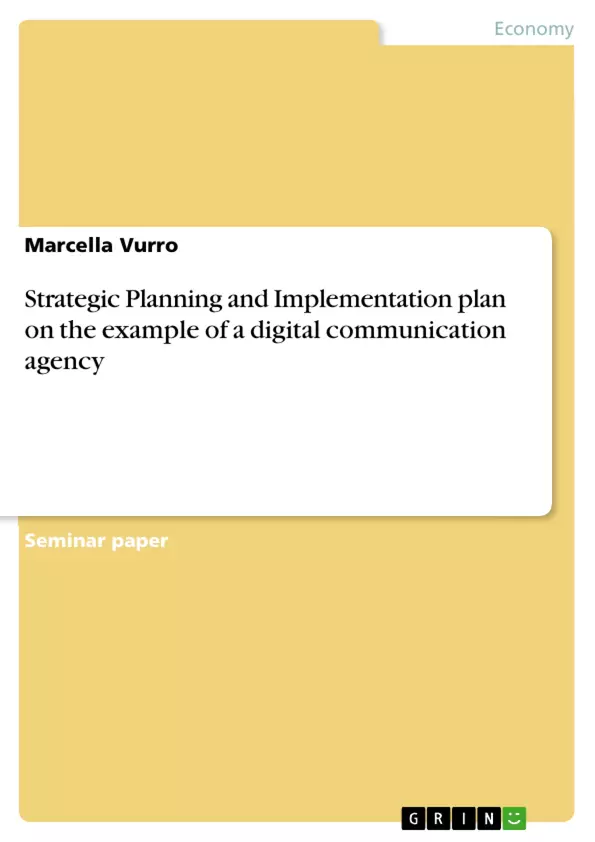The following Strategic Planning and Implementation assignment deals with an online advertising agency, that is embedded into a worldwide operating agency network, in the following called “group”. The below developed strategic plan is designed to give a structured approach to the achievement of the company’s objectives.
Table of Contents
- 1. Introduction
- 2. Management strategy
- 2.1 Structure for integration of stakeholder's into the process
- 2.2 Criteria to develop potential options
- 2.3 Strategy
- 3. Mission, vision, objectives and measure
- 3.2 Mission and vision statements
- 3.3 Objectives evaluation measures
- 4. Strategy implementation plan
- 4.1 Timetable
- 4.2 Dissemination processes
- 4.3 Monitoring and evaluation systems
Objectives and Key Themes
The objective of this strategic planning and implementation assignment is to provide a structured approach to achieving the objectives of a digital communication agency within a global network. The plan aims to integrate stakeholder perspectives and develop a robust implementation strategy.
- Stakeholder Management and Integration
- Strategic Planning and Goal Setting
- Implementation Strategies and Timelines
- Monitoring and Evaluation Processes
- Effective Communication and Stakeholder Engagement
Chapter Summaries
1. Introduction: This chapter introduces the subject of the strategic planning and implementation assignment, focusing on an online advertising agency embedded within a larger international network. It sets the stage by outlining the plan's goal: to provide a structured approach for achieving the company's objectives. The agency's position within a larger group is emphasized, suggesting the complexities inherent in strategic planning within such a context.
2. Management strategy: This chapter delves into the crucial aspect of stakeholder management within the strategic planning process. It begins by defining stakeholders using established definitions from Hill & Jones (1998) and Hannagan (2002), highlighting the importance of their power and interest levels. The chapter then outlines a framework for categorizing stakeholders based on their power and interest, proposing different engagement strategies for each category (EC-FAO, 2009). This categorization emphasizes proactive engagement with high-power stakeholders and informed communication with others. The importance of effective communication in maintaining commitment is stressed (GDS, 2009). The chapter concludes with a step-by-step process (Mind Tools Ltd, 2006) for identifying, prioritizing, and anticipating stakeholder reactions, showcasing a practical approach to stakeholder integration within strategic planning. The example of the agency's General Manager, Senior Management, shareholders, employees, clients, and the government are used to illustrate different stakeholder classifications and engagement strategies.
Keywords
Strategic planning, implementation, stakeholder management, digital communication agency, objective setting, communication strategy, monitoring, evaluation, agency network.
Strategic Planning and Implementation for a Digital Communication Agency: Frequently Asked Questions
What is the main objective of this strategic planning document?
The primary objective is to provide a structured approach for achieving the objectives of a digital communication agency operating within a global network. The plan aims to integrate stakeholder perspectives and develop a robust implementation strategy.
What key themes are addressed in this document?
Key themes include stakeholder management and integration, strategic planning and goal setting, implementation strategies and timelines, monitoring and evaluation processes, and effective communication and stakeholder engagement.
What topics are covered in the Table of Contents?
The document covers an introduction, management strategy (including stakeholder integration, criteria for developing options, and overall strategy), mission, vision, objectives, and measures, and finally, a strategy implementation plan (including timetable, dissemination processes, and monitoring and evaluation systems).
How does the document address stakeholder management?
The document uses established definitions from Hill & Jones (1998) and Hannagan (2002) to define stakeholders and emphasizes the importance of their power and interest levels. It outlines a framework for categorizing stakeholders and proposes different engagement strategies for each category (based on EC-FAO, 2009). A step-by-step process (Mind Tools Ltd, 2006) for identifying, prioritizing, and anticipating stakeholder reactions is also presented.
What specific stakeholders are mentioned in the document?
Examples of stakeholders discussed include the agency's General Manager, Senior Management, shareholders, employees, clients, and the government.
What is included in the chapter summaries?
Chapter summaries provide concise overviews of each section, highlighting key concepts and arguments. The introduction sets the context, the management strategy chapter details stakeholder management, and subsequent chapters cover the implementation plan.
What are the key words associated with this document?
Key words include strategic planning, implementation, stakeholder management, digital communication agency, objective setting, communication strategy, monitoring, evaluation, and agency network.
What is the overall structure and approach of the document?
The document follows a structured approach, moving from introducing the objectives and key themes to outlining a detailed plan including stakeholder management, strategy development, and implementation. It uses a combination of theoretical frameworks and practical examples to illustrate its points.
- Citation du texte
- Dipl. Kommunikations- und Marketingwirtin Marcella Vurro (Auteur), 2009, Strategic Planning and Implementation plan on the example of a digital communication agency , Munich, GRIN Verlag, https://www.grin.com/document/127248



